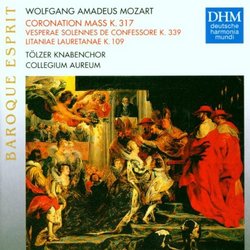| All Artists: Collegium Aureum Title: Mozart: Coronation Mass K317 Members Wishing: 0 Total Copies: 0 Label: Deutsche Harm Mundi Original Release Date: 1/1/1998 Re-Release Date: 9/14/1998 Album Type: Import Genre: Classical Style: Number of Discs: 1 SwapaCD Credits: 1 UPC: 054727747021 |
Search - Collegium Aureum :: Mozart: Coronation Mass K317
CD Details |
CD Reviews3.5 stars for a better than average performance with some mi Larry VanDeSande | Mason, Michigan United States | 05/02/2008 (3 out of 5 stars) "Collegium Aureum, often led by concertmaster Franzjosef Meier, was one of the first period ensembles in Europe that began recording music in the now-common authentic style, using period instruments, during the 1960s and 1970s. The instruments they play often sound better than the out of tune, screechy and tired strings, brass and woodwinds we heard in the 1980s. They often played one to a part in Bach recordings, also.
Here they collaborate with some European singers to perform Mozart's "Coronation" mass, the six Vesperae de Solennes de Confessore (of which "Laudate Dominum" is a standard for coloratura soprano recordings) and the early (K. 109) Litaniae Lauratanae. The group performs with a chamber choir and soloists, none of whom you've ever heard of. The recordings were made during from the mid-1960s to mid-1970s. What struck me most when I listened to the opening Kyrie of the mass is the female parts and solos were sung by boy trebles. This is true for the Vespers too. It was a tad disconcerting to hear boys' voices when expecting women, but I made the adjustment very quickly, mostly due to the fact that this is a highly charged and equally committed recording of Mozart's mass. Compared to the last one I heard, a super audio recording by Marcus Bosch and a group of young German singers, I like this recording equally as much and perhaps prefer it in terms of sound. That's not to say this 30-year-old recording competes with today's SACD productions; it's merely to say I like the goings-on more, especially the full-throated passion and old time German mechanics of these singers mated to the playing of Collegium Aureum on their elderly instruments. Where the boy trebles becomes an issue is during the Vespers and, especially, in the most popular of them, Laudate Dominum. Not only is the whole thing way too slow -- pedantically slow, almost -- the boy singer struggles to maintain pitch during the proceedings. He lacks depth, projection and flexibility in his voice, as you might imagine, and is too closely miked, making every fault that much larger. The whole thing comes off as a loss without much value. All the other Vespers, oddly, are very upbeat and performed at a much higher plane of confidence and competence with a vigor missing in this one. It's clear they tried to do too much with the famous one. The finale is a 13-minute sacred choral piece performed by a traditional f-f-m-m quartet and the orchestra. It is composed in five sections but played in one long track on this recording. The whole thing is a lot more mellow than the rest of the recording and the tire pressure, you might say, it a tab low to ensure a smooth, almost mushy, ride. After hearing it, I wished the mass and Vespers had been sung by this quartet. Still, they are pretty damn good as they are. If you have any interest in early period performance or any of the performers, I think your interest will be satiated by acquiring this one." |

